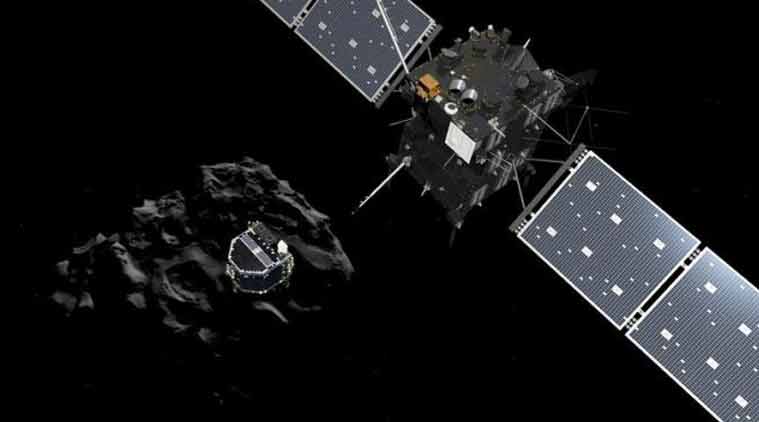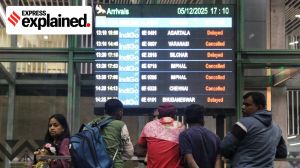Stay updated with the latest - Click here to follow us on Instagram
European probe ‘Philae’ lands on comet
Engineers are yet to figure out what prevented the 100-kilo (220-pound) lander from shooting its duo of harpoons into the comet's surface.
 A handout artist impression showing lander Philae separating from the Rosetta spacecraft and descending to the surface of comet 67P/Churyumov-Gerasimenko, made available by the European Space Agency (ESA) on November 12, 2014. (Source: Reuters)
A handout artist impression showing lander Philae separating from the Rosetta spacecraft and descending to the surface of comet 67P/Churyumov-Gerasimenko, made available by the European Space Agency (ESA) on November 12, 2014. (Source: Reuters)
Europe has made history by placing the first-ever lander on a comet – but the robot failed to anchor itself properly, raising concerns at ground control.
The fridge-sized lab dubbed Philae touched down on comet 67P/Churyumov-Gerasimenko in a high-risk manoeuvre more than 510 million kilometres (320 million miles) from Earth, the European Space Agency (ESA) said Wednesday.
But instead of harpooning itself to the surface after a seven-hour descent from mothership Rosetta, early radio signals suggest Philae could have settled in a soft surface or gently lifted off and then redescended.
“So maybe today we didn’t once, we even landed twice,” Philae lander manager Stephan Ulamec quipped at ground control in Darmstadt, Germany a few hours after touchdown.
“Hopefully, we are sitting there on the surface at a position slightly different to the original landing and can continue our science.”
Several instruments onboard Philae had already sent back “plenty of data,” he said.
Engineers are yet to figure out what prevented the 100-kilo (220-pound) lander from shooting its duo of harpoons into the comet’s surface to prevent it drifting away from its low-gravity host. Nor is its fate entirely clear.
“Did we just land in a soft sandbox and everything is fine even though we are not anchored… or is there something else happening?” said Ulamec.
With communications between Philae and its parent severed for the coming hours, expected as Rosetta disappears in orbit behind the comet, there may be scant information before a media briefing planned for 1300 GMT today.
There was cause for celebration as Philae separated from Rosetta as scheduled and headed for “67P” after a decade-long trek covering 6.5 billion kilometres (four billion miles).
A crowd of scientists, guests and VIPS, including two Ukrainian astronomers who discovered the comet in 1969, then cheered as the signal arrived on Earth to confirm contact with the comet.
“This is a big step for human civilisation,” said ESA director general, Jean-Jacques Dordain.
“Our ambitious Rosetta mission has secured another place in the history books. Not only is it the first to rendezvous with and orbit a comet, but it is now also the first to deliver a probe to a comet’s surface.”
Jim Green, director of planetary science at NASA, heaped praise on the feat.
“How audacious, how exciting, how unbelievable to be able to dare to land on a comet, to take that step that we’ve all wanted from a scientific perspective,” he said.
- 01
- 02
- 03
- 04
- 05































